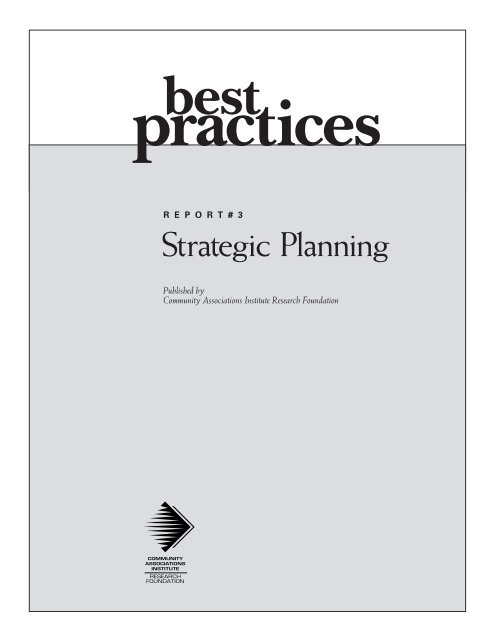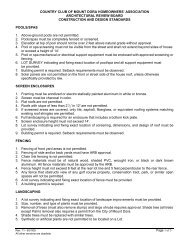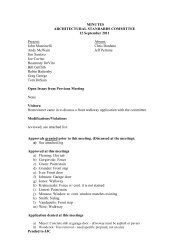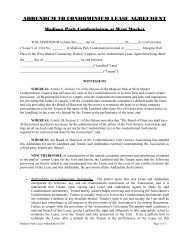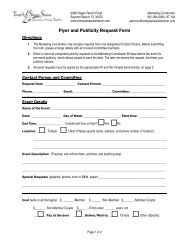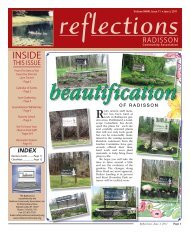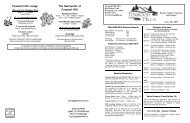Strategic Planning - Community Associations Network
Strategic Planning - Community Associations Network
Strategic Planning - Community Associations Network
You also want an ePaper? Increase the reach of your titles
YUMPU automatically turns print PDFs into web optimized ePapers that Google loves.
AcknowledgementsPanel MembersJudy Farrah, CMCA ® , PCAM ®Rob Felix, CMCA ® , PCAM ®Jo-Ann Greenstein, CMCA ® , AMS ® , PCAM ®Ellen Hirsch de Haan, Esq.Mike Levin, PCAM ®Eric MatsumotoJudy Burd Rosen, CMCA ® , AMS ® , PCAM ®Carole Sappington, PCAM ®Robert H. SchwartingDebra Warren, CMCA ® , PCAM ®Copyright and Use Permission©Copyright 2001. by <strong>Community</strong> <strong>Associations</strong> Institute Research Foundation.225 Reinekers Lane, Suite 300Alexandria, VA 22314Readers are allowed to printout and reproduce this Best Practices report for use by community associationmanagers, board members, individual homeowners, and community association related industry professionalswithout permission of the copyright holder provided the following terms are met: this document must bereproduced in its entirety including the copyright statement of ownership; this document may not be addedto, modified, amended, or otherwise altered from the original as presented here. Readers and users agree notto sell copies of this document or otherwise seek compensation for its distribution.“This document is designed to provide accurate and authoritative information in regard to the subject mattercovered. It is provided with the understanding that the publisher is not engaged in rendering legal,accounting or other professional services. If legal advice or expert assistance is required, the services of acompetent professional should be sought.”—From a declaration of Principles, jointly adopted bya Committee of the American Bar Association and a Committee of Publishers.2
SECTION THREEComponents of <strong>Strategic</strong><strong>Planning</strong><strong>Strategic</strong> planning’s three main components are plan development, plan execution, andplan review. Many of the functional areas within these components are similar in that allthree require a team concept that is based on: ensuring the member’s roles are defined, educatingteam members about the process, and using quality communication when interacting.Plan DevelopmentPlan development is the first component of strategic planning. During this stage, the followingsteps should be completed.1. Assess the association’s history and significant accomplishments. Develop a history ofthe association. List important milestones that brought the association to where it istoday. In order to help visualize how the association has changed over the years,include items where impact occurred in the association’s operations, such as: hiringadditional staff, upgrade computer hardware/software, changing processes significantly,raising dues, building additional facilities, rebuilding/renovating existing facilities,etc., by dates and quantities/dollars, as appropriate.2. Assess the association’s current status. Determine the association’s current status bylooking at such things as the state of the facilities, infrastructure of the operations, thefinancial statements, the demographics of the population, and so forth.3. Evaluate the association’s current governance structure. Review the operations todetermine how responsibilities are assigned, defining communications and authorities.Examine policies, procedures, and desk guides available to determine the chainof command within the association’s staff, within the board, and for oversight andcommunications between the staff or property management company and the boardof directors. Critical is the point of contact for the staff or management company andthe board, to preclude misunderstandings, duplications of effort, things fallingthrough the cracks, etc.a. Determine the board’s responsibilities versus that of the staff or managementcompany’s responsibilities. An example of a delineation of responsibilitiesbetween the staff or management company and the board is covered in PolicyGovernance, which simply stated, assigns the board’s function as that of policymaking, the “what is” of the subject/issue, while the staff’s or management company’sfunction is that of carrying out the policies, the “how to” of thesubject/issue. See Best Practices Report #2: Governance, Resident Involvement & ConflictResolution for a detailed description of Policy Governance.4. Develop mission and vision statements. The vision statement is the image or stateto which the association aspires. It emphasizes the dream of where the associationwill be at a specific time. The mission statement is the organization’s purpose statedin a memorable phrase. In short, an association’s mission statement describes the8
S T R A T E G I C P L A N N I N Gsample mission statementTo provide services to our community and to our member property owners as definedby the KICA Board in response to member preferences. Of particular emphasis areefforts to build a stronger Sense of <strong>Community</strong>, efforts to resist crowding, and efforts tomaintain our environment. This will be done in a manner that provides for the preservationof values, for the maintenance of common facilities and services, and for a vehiclefor the administration and enforcement of covenants and restrictions.—From Kiawah Island <strong>Community</strong> Association’s Long Range Plan Report, August 14, 2000business it’s in. It should be geared toward fulfilling the association’s purpose andwhat it is intended to do with some specifics contained in the governing documents.Mission and vision statements should not be a list of goals.5. Determine operating values. Also called guiding principles, these values state theassociation’s intentions and expectations. They are used to judge the association’spolicies and actions, as well as individual conduct. <strong>Associations</strong> should include valuessuch as: the importance of customers and customer service; commitment toquality and innovation; importance of honesty; integrity and ethical behavior; corporatecitizenship; respect for the employee and duty the association has to itsemployees; and importance of safety and protecting the environment, etc.6. Perform a needs assessment. Determine the needs of the association by analyzingthe present state of the community, addressing any critical issues, and identifyingthe association’s strengths, weaknesses, opportunities, and threats.a. Determination of key result areas. Define five to ten areas in which the associationmust be successful in order to accomplish its mission, based on customerexpectations.i. Determine customer expectations. Determine the customer [members, suppliers,and employees] expectations of the association as stakeholders. Groupthe expectations into five to ten key results areas.7. Determine critical issues. List the critical issues faced by the association that mustbe addressed for the association to achieve its mission and vision, based on anassessment of its strengths, weaknesses, opportunities, and threats.a. Assessment of strengths, weaknesses, opportunities, and threats (SWOT)i. Strengths. List the organizational attributes that promote the association’sability to meet its mission and vision.ii. Weaknesses. List those organizational attributes that hamper the association’sability to meet its mission and vision. Some examples include inadequate technologyor use of technology, lack core competency training, poor service, andso forth.iii. Opportunities. List those factors, internal and external, that would enable theassociation to meet its mission and vision. Some examples include technologicaladvances in needed areas, consolidating functions, etc.9
sample vision statementThe Vision of the Kiawah Island <strong>Community</strong> Association is that it will take the lead in:• providing a sense of community and enriched quality of life for its members,• encouraging members to be good stewards in meeting their responsibilities to eachother, to the greater community that surrounds us and to the preservation of the naturalqualities that enrich our island existence,• offering every opportunity for its members to enjoy personal growth while respectingtheir heritage as a community and as individuals,• ensuring that wellness, both in the maintenance of our good health and in the funand joy experienced in life on Kiawah, is protected and nourished,• contributing positively to members’ investment in Kiawah, particularly in preservingproperty values, and• above all, guaranteeing that pursuit of excellence in all the Association does is itsguiding principle.—From Kiawah Island <strong>Community</strong> Association’s Long Range Plan Report, August 14, 2000iv. Threats. List those factors, internal or external, that would hamper the associationfrom meeting its mission and vision. Some examples include high rateof foreclosures, drawn out worker strike, change in developer focus, etc.8. Define the roles of key players. Who will be the key people responsible for eachaspect of the strategic plan? Answer questions such as: What level of control willthe board have? Is the manager going to be a proactive leader or an administrator?Are the homeowners going to be active as committee members or are they goingto be less involved? Role definition is extremely important so that efforts are notduplicated—or neglected overall. One way to establish a team and define specificroles is to adopt a model similar to a city council and city manager form of government.The city council (board of directors) sets policies, votes on contracts andbids, and is the on-site eyes and ears (oversight) of the community. The city manager(management) should be the professionally educated, proactive, paid leaderwho manages the day-to-day operations, brings issues and solution options to thetable, and then implements the board’s decisions. The citizens (homeowners)should attend meetings, serve on committees, and elect competent individuals tothe board of directors. This concept of team roles goes much deeper than this discussionallows, especially in the areas of compliance, budgeting, and homeownerinteraction.9. Educate and communicate the plan. Without education and communication, teammembers can neither perform their roles nor effectively interact with each other.Make sure that every player has the necessary documents and basic knowledge toperform effectively. Further ensure that each of the players communicate with eachother—provide updates as necessary and always ask for others’ input. Better tocatch a potential problem earlier rather than later. In the event that there is achange in management, association boards should also be sure to communicatetheir strategic plans to the new manager, and revise it, if necessary. Also, if the10
S T R A T E G I C P L A N N I N Gcharacteristics of a useful strategic plan(from Professional Practices in Association Management, John B. Cox, CAE, Editor, AmericanSociety of Association Executives, 1997)A useful strategic plan exhibits many characteristics. Specifically, it should be:1. A set of priorities. Setting priorities allows for the plan to be adjusted according tochanging needs or resources.2. Achievable, measurable, and time sensitive. Remember, it’s better to do a few thingswell than many things poorly. The plan should contain goals that are measurable andhave deadlines.3. Flexible and responsive to changing conditions.The plan is a road map that may containunforeseen detours such as unexpected crises, new opportunities, or changes inresources.4. Short and simple. Plans that are more like a book will sit on a shelf. Keep it focused onthe most important things to accomplish.5. A unit, not a menu. A useful plan is not a wish book. Everything in the plan needs to beaccomplished.6. The means to an end, not an end in itself.The plan is the process by which it reaches itsdestination; it is not the destination.7. Based on a three- to five-year period.The strategic plan should be a living documentthat has a one-year drop off and a new year added so that it always covers the sametime period.<strong>Strategic</strong> Plan calls for specific management participation, make sure it is spelledout in the management contract.10. Listen and take notes. During the strategic planning process it is important for all partiesto actively listen and take notes. Many type-A personalities, who may be involvedwith the association at any level, will want to solve the community’s issues quickly andefficiently. If they do this without listening to the board of directors, homeowners,and vendors, they may be executing a plan, but not a quality strategic plan.11. Develop and prioritize long-range goals. Develop long-range goals to address thecritical issues identified through the needs assessment; then prioritize those goals.12. Develop short-term goals and action plans. Establish short-term goals and specificaction plans along with scheduled completion dates.13. Monitor the progress. Establish a monitoring process to assess the progress madeon both short-term and long-range goals.Plan ExecutionPlan execution is the second phase of strategic planning. In this step, an association putsits plan into action through the allocation of resources. This step has three components:1. Programs. Association programs serve as blueprints for converting objectives intorealities.2. Procedures. Procedures are the specific sequence of tasks required to complete theprograms.11
sample agenda for a strategic planning session(from <strong>Community</strong> First! Bill Overton, PCAM, Editor, published by <strong>Community</strong> <strong>Associations</strong> Press,1999)• Introduction and review of the process.• History of the association and its significant milestones.• Overview of the community today.• Review of current governance structure.• Development of association mission and vision statements.• Challenges and threats to the association.• Opportunities for improvement.• Classification and prioritization.• Implementation: timeline and responsibility assignments.• Summary and conclusion.3. Budgets. An association should prepare budgets to fund programs. Instead, manydevelop programs based on their budgets. Simply put, an association should bestrategy-driven, not budget-driven.If the plan development phase was put together well, then the plan execution phaseis much easier. Many of the previously discussed items such as teamwork, roles, communication,and education are important and apply to the plan execution phase. Holdperiodic meetings to review progress on short-term goals and plans. Without periodicmeetings and reviews, the community will not move forward and achieve its goals.Lastly, adaptability is crucial to the plan execution phase since all plans will have flaws.If the team members are not adaptable, there may be simple issues that will not beresolved in a reasonable manner and the community will suffer.Plan ReviewPlan review is required constantly to improve the plan and ensure its execution. Part ofthe plan review occurs naturally when there’s board turnover, a new homeowner, orchanges in the law. In addition, plan review needs to be scheduled to ensure the plan ismeeting the community’s goals. This can be achieved through surveys, managementreview conferences, or discussions at meetings. If the community fails to update theplan, the plan will eventually fail the community. Industry experts suggest that associationsand their managers review their strategic plans annually and completely overhaultheir strategic plans every three to five years.Use of a ConsultantAn outside consultant or professional facilitator brings impartiality, pointed questions,and the facilitation skills needed to balance differences of opinion. <strong>Associations</strong> shouldbe aware that consultants will take different approaches to strategic planning as no one,right way exists. While hiring a consultant can be expensive, he or she will greatly acceleratethe association’s learning curve and help to ensure that the strategic planning12
S T R A T E G I C P L A N N I N Gpitfalls to be avoided in the long-range planning process(from “A Roadmap to the Future, The Importance of Long-Range <strong>Planning</strong>” by Bernard Steiner,Common Ground, January/February 1986.)• Becoming so engrossed in current problems that insufficient time is spent on long-rangeplanning, and the process becomes discredited.• Failing to assume the necessary involvement in the planning process by other associationcommittees.• Failing to use plans as standards for measuring performance.• Consistently rejecting the formal planning mechanism by making intuitive decisionswhich conflict with the formal long-range plan.• Failing to develop association goals suitable as a basis for formulating long-range plans.process will complete a full cycle. If budgetary restraints do not allow for such assistance,associations may want to consider using a consultant for the initial sessions,where an objective assessment of the association’s current position is necessary.13
Case Studies of <strong>Strategic</strong> <strong>Planning</strong>case study #1Village at Craig Ranch Homeowners AssociationSize:206 single family homesAge:Six (6) yearsLocation: North Las Vegas, NevadaBoard Size: Three (3)Contact: Kevin RuthE-mail: thoroughbredmgt@juno.comThe Village at Craig Ranch Homeowners Association (VCR) is a common-interest communitythat transitioned from developer control in 1998. The association has a five-acrepark with a gazebo and children’s play equipment, an RV parking area, two tennis courts,two sets of vehicle and pedestrian gates, perimeter landscaping, private streets, and anoverflow parking area.By the fall of 1998, the board recognized that the community had some serious problems.The association had less than $5,000 in its reserves, the gates had not worked formore than two years, the community did not have standing committees, and there wereseveral major construction defects in the common areas and the homes. Delinquenciestotaled more than $20,000, the reserve study wasn’t current, and the managementcompany and the board had an adversarial relationship. More over, there were five peopleelected to the board, but the governing documents only allowed three. The only wayto rescue the association was to develop, execute, and review a strategic plan.First, the association hired a new management company. During the search and interviewprocess, the board honestly portrayed the association’s condition and stressed thatthe association needed help. Upon hiring a new management company, the board andits manager scheduled several meetings to fully discuss the community’s issues anddevelop a plan to remedy the problems. During these meetings, the central theme wasteam development, and the roles and responsibilities of each of the individual playerswere established.Next, the board and manager listened to the homeowners’ needs and ideas. Theboard scheduled two meetings during which 90 percent of the agenda was dedicated tohomeowner input. The board and management also used these meetings to begin thehomeowner education process. After that, the board and manager set out to prioritizethe association’s issues and needs. The association consulted with various experts—including attorneys, gate maintenance vendors, accountants, and the association’s developer—tohelp with this process. Based on this feedback, management developed a draftplan and presented it to the board, which subsequently approved it. The report concludedthat it would take two to three years to resolve the community’s significant issues andstabilize the association. The plan was presented to homeowners both during the nextmeeting and in a mailing that included a request for input. The most significant concernwas the lengthy timeframe for reaching stability, but once the attorneys explained theconstruction defect process, the homeowners understood the issue.With everyone focused on the plan, the team began the execution phase.Management sent a request for nominations to elect a legitimate, three-person board. Theboard was elected and ratified the previous board’s decisions. The board established aWelcoming/Social Committee, a Rules Development Committee, and an Architectural14
S T R A T E G I C P L A N N I N GReview Committee. Homeowners volunteered to serve on these committees. TheSocial/Welcoming Committee plans three major social events each year, coordinates withmanagement, formally welcomes all new homeowners, and serves refreshments at allboard meetings. The Rules Development Committee assembled a four-page set of rulesand regulations by taking the everyday rules from the governing documents and addingsome other common-sense-based rules. Compliance issues have dropped significantly.An assessment collection policy was established and reviewed by an attorney, as wasa plan for those homeowners who were significantly delinquent. In the first year, delinquencieswere reduced by almost $10,000. After 18 months, the common-area constructiondefect litigation was resolved. The developer paid for a comprehensive independentreserve study and appropriately funded the association’s reserves. In addition toappropriate funding, the developer fixed the gate issues, sealed the streets and RV area,striped the RV area, and provided funds for other required maintenance.Throughout the plan’s execution, the board, homeowners, management company,and other vendors reviewed and updated the plan many times. Through this reviewprocess the team avoided many costly errors. During the review process, new planswere developed and executed. The largest of these is the establishment of an ad hoccommittee to convert one of the tennis courts over to an all-purpose sports court primarilyfor children. Additionally, parking enforcement procedures were established, whichreduced resident street parking from 75 cars to less than five per night. The reviewprocess continues as there is an annual survey mailed out to all homeowners. The boardand management formally review the team’s performance twice a year.Currently, the association is functioning extremely well. Reserves are 100 percentfunded, common area maintenance is ahead of schedule, committees are establishedand working, and assessments have remained level. The association members are muchhappier as they have seen their community flourish. Not everything is perfect in the associationbut the board and management continue to communicate and educate theteam—and work toward its goals. With strategic planning, the Village at Craig RanchHomeowners Association knows not only where it is, but also where it is going.case study #2Desert Shores <strong>Community</strong> AssociationSize:3100-unit mixed-use master-planned communityAge:Thirteen (13) yearsLocation: Las Vegas, NevadaBoard size: Five (5)Contact: Donna KitchenEmail: DSCAcommgr@aol.comStarted in 1988, Desert Shores was the second master-planned community built in LasVegas. The master developer designed the overall concept and closely supervised constructionby twenty-two participating builders. Amenities include a 1500-square foot clubhouse,and a 200,000-gallon swimming pool designed to look like a tropical lagoon, surroundedby palm trees and a sand beach. Desert Shores’ best-known amenities are itsfour man-made lakes, which cover sixty surface acres, are fully stocked with fish, and aredesigned for small electric powered and pedal boats. The lakes are surrounded by more15
than thirty acres of landscaped common area, designed with heavy concentrations oftrees, palms, shrubbery and turf grass.From its inception, Desert Shores benefited from the effort of the master developerto involve and train volunteer homeowners on the board of directors and various advisorycommittees. When the developer transitioned the community to homeowner control,a full reserve study update was completed, proving the reserve fund to be adequatelyfunded. Having experienced such a smooth transition, the Desert Shores board of directorsadopted the reserve study as their master plan for operations for the next few years.The association sailed through its first seven years, maintaining the common areaaccording to original standards, supporting operational costs and continuing to fund thereserves—all without an increase in assessments.In 1997, as landscape maintenance and replacement costs continued to rise and thatbudget item, combined with the rising cost of water, became a major portion of the operatingbudget, it was apparent that action needed to be taken. The board decided the situationneeded re-evaluation and some strategic planning. The first step toward strategicplanning had already been taken—the problem had been identified. The board needed tofind a way to maintain the ambiance of their community and still keep budgeted andreserve funding at adequate levels. The second step was to assemble a team to evaluatethe problem.Members of the board volunteered to serve on an ad hoc committee, along withother homeowners with volunteer experience on committees in the community andmembers of the management staff. They reviewed the latest update of the reserve studyand reviewed the association’s current financial status with the accounting director andthe contracted CPA. They met with landscape experts and their current landscape contractorto discuss possible changes in materials and maintenance. They also took advantageof the local water district’s policy and requested a water audit of the commongrounds by their expert.In meetings that included the board, committee members, management, and thelandscape contractor, the results of the financial analysis and water audit werereviewed. The review showed that, with long range planning, the current irrigation systemand landscape design could be modified to be more water efficient, with conversionto better equipment and drought-tolerant xeriscape landscape design. The conversioncould be accomplished using a combination of budgeting operations and reservefunds, without having to raise assessments or issue a special assessment. The boarddecided to implement this plan on a test area where problems with maintenance andvandalism had escalated costs.During the process, a series of articles about the rising costs of maintaining the turflandscape were published in the community newsletter and several informative mailingswere sent out to the residents. Owners were kept well informed of the progress andinvited to review the results for themselves. While there were a few complaints fromthose who preferred green pastures to the rock and desert plants that made up thexeriscape plans, the conversion was an overall success with the residents.Now, four years after the plan was put into place, nearly one-third of the turf grassareas have been converted to xeriscaping. The community submitted the plan to the localwater district and has received nearly $15,000 in credits. This is barely ten percent of thetotal cost to date, but was an unexpected bonus over the water and maintenance savings.The last step of any strategic plan is evaluation and there is little doubt that thisongoing plan has been a resounding success. It has even fallen in line with the City ofLas Vegas water conservation campaign and inspired many homeowners to convert theirlandscape after viewing how lush and beautiful even drought tolerant plants can be. The16
S T R A T E G I C P L A N N I N Gboard and management are continuing to work with the landscape contractor to map outareas for conversion to this new plan.Recently, after nearly twelve years, Desert Shores is experiencing problems withmaintenance, damage, and replacement of mature trees throughout the community.Many of the desert tolerant pine trees have reached heights of thirty to forty feet andseveral have fallen in the high winds that are common in this area. In addition, thesetrees have become difficult to trim and are creating a nuisance as they shed onto thehomeowners’ property. This issue will be studied and a new strategic plan will be developedand implemented over the next five years. The same five-step method of identifyingthe problem(s), establishing a plan, implementing the plan, communicating to thehomeowners, and evaluating the results will be used for the next strategic plan.In July 1989, the Pelican Cove Condominium Association board of directors formed a<strong>Planning</strong> Committee to discuss the concerns of owners and develop strategies toaddress these concerns. At that point, there was a general feeling that time had becomean enemy of the association. The buildings and grounds were being neglected—roofs,stairs, pools, and trees were all in dire need of attention. Board committees were ineffectivedue to lack of direction and the absence of financial scrutiny was apparent.Following a year of weekly meetings, the <strong>Planning</strong> Committee published to the membershipan eighteen-page document titled One-Year and Five-Year Plans. As a result ofthis thorough review, new management was hired, a seven-year special assessment forroof replacement was levied, and the community was forced to examine the futureneeds of Pelican Cove. The <strong>Planning</strong> Committee continues to publish a long-range planeach year as a reminder that past accomplishments do not guarantee future success.Unit owner surveys allow for necessary resident feedback on how the association ismeeting their individual needs. The survey results are compiled, examined by the committeeand often become the basis of the annual plan.In recent years, all of the association’s large capital projects have appeared as majortopics in the plan—roof replacement, water conservation, and harbor dredging to namea few. Most recently, the idea of building a new clubhouse on the property first appearedas a topic in the 1996 plan. This one article was enough to plant the seed in many mindsthat this type of building was needed in order to support the activities of this bustlingcommunity. The resulting facility was completed in November 2000—on time and onbudget—as the result of good planning.One of the most significant issues currently facing Pelican Cove involves electroniccommunications. Several pages of the 2001 long-range plan were dedicated toinforming residents as to how this topic pertains to them as individuals. With a multicasestudy #3Pelican Cove Condominium Association, Inc.Size:731 condominium unitsAge:Twenty-six (26) yearsLocation: Sarasota, FloridaBoard Size: Nine (9)Contact: Robert Malan, General MangerE-mail: pelicancove@home.com17
year cable contract set to expire in December 2002, the association must seek alternativeapproaches such as satellite providers. Would the costs be less? Would thereception be better? Would more expanded programming be available? Would theinterior wiring need to be replaced? These are just a few of the questions the <strong>Planning</strong>Committee is currently asking.This committee and its annual plan and survey have become mainstays of thecommunity. While actively concentrating on key concerns facing the community, thecommittee seeks to provide answers necessary in order to preserve, protect, andimprove Pelican Cove.case study #4Crystal Lakes Road and Recreation AssociationSize:1,669 properties, 1,478 members, 5,000 acres18Age:Thirty-three (33) yearsLocation: Larimer County, ColoradoBoard Size: Seven (7)Contact: Richard G. Rosecrans, ManagerE-mail: clroad1@mindspring.comDuring fiscal year 2000–2001 the association’s board of directors asked the <strong>Planning</strong>Committee to initiate a project with the following goals:1. Establish the association’s present position in reference to its governing documentsas well as the future goals of, and the threats to, the association as a result of needsand desires resulting from the requirements established by those documents.2. Develop a realistic and concise mission statement.3. Develop a realistic and concise vision statement.4. Develop realistic short and long term goals; which, when accomplished, would furtherthe mission and vision as stated.5. Analyze present and future staffing needs based upon specific present and futurefunctions that need to be accomplished.After several months of initial study and information collection by the <strong>Planning</strong>Committee, the board concluded that the assistance of a professional consulting firmwould be necessary to complete this project. The board hired a consulting firm to assistwith the completion of the project, which lasted for more than eight months. During thistime, each board member spent approximately 50 hours of meeting and study time onthe project. The final product of this study was the association’s business plan and staffposition plans, which were mailed to each association member in May 2001. The plansreceived a very positive response from the membership.To date, the business plan has already resulted in several positive results.1. Staff efficiency has improved by virtue of each staff member having a better understandingof their personal goals within the organization and the specific goal of theassociation.2. An additional staff member has been added effective June 1, 2001 with initial positiveresults.3. All staff members have received evaluations based upon their position plans andassociation goals.
S T R A T E G I C P L A N N I N G4. Many of the short-term goals, as stated in the plan, have been accomplished andprogress toward accomplishment of long-term goals is going well.5. The plan has focused the board and the staff toward greater community supportfor the betterment of all concerned.The total project expense, including copying and mailing, was approximately $10,000.The association learned a valuable lesson during the development of this plan: when youare required to professionally analyze your operation, to state your present situation andyour future goals in writing, your sense of direction and spirit of accomplishment are greatlyenhanced. The association’s board deserves great credit for its commitment to developthis business plan and should be rewarded for its efforts. The association is dedicated toannual review and update of the plan in order to sustain the momentum which has beencreated. Membership input to these updates is paramount in the board’s desires.case study #5Siena <strong>Community</strong> Association, Inc.Size:380 (as of July 2001), 1927 upon build-outAge:Location:Board size:Contact:E-mail:One-and-a-half (1 1 ⁄2) yearsLas Vegas, NevadaThree (3) declarant representativesJohn J. Holden, CPA, CMCA ® , Managerjholden@sunriseco.comOnly a year-and-a-half old, Siena is a guard-gated, master-planned, age-qualified communityconsisting primarily of single-family detached homes. There are plans for approximately100 attached townhome-style structures. Amenities include a 16,000-square-foothealth and fitness center, a temporary 10,000-square-foot social center, common-arealandscaping, and an entry fountain. In 2003, the builder will construct a 40,000-squarefootpermanent community center. The association offers many activities for its residentsincluding bocce clubs, water aerobics, ceramics and computer classes, social and holidaydances, mixers, and excursions.The purpose of Siena’s strategic planning is to provide the association with stablemanagement and financial structure to successfully and efficiently transition from developercontrol. The major goals include: avoiding special assessments, avoiding largeassessment increases after developer transition, and avoiding homeowner lawsuits.These goals contribute to the existence of a comfortable and stress-free communityassociation living experience for residents.To achieve these goals, the association will have an interim reserve study and areserve study when construction is complete to ensure that the association’s reservesare fully funded at the time of transition. State laws require these items, but it is theassociation’s intent to incorporate homeowners into the process and to provide themwith updates. In addition, some homeowners will sit on a transition team and be chargedwith the responsibility of studying the association’s management operations and makesubsequent recommendations.One advantage of strategic planning in this instance is that homeowners have a voicein association management. It is also an organized way to collect homeowner input andinitiates an objective, fact-based method by which the association collects this input.19
case study #6Tellico VillageSize:2,100 single-family homes and townhousesAge:Fifteen (15) yearsLocation: Loudon, TennesseeBoard size: Seven (7)Contact: Don MillerE-mail: TVdrMiller@aol.comTellico Village is a recreational community with 4,300 residents, 135 staff members, andan annual budget of approximately ten million dollars. The association has three golfcourses, a recreation center, a yacht club restaurant with about 400 docks, water andsewer systems, roughly 100 miles of private roads, and a volunteer fire deptartment.There are eight volunteer property owner committees that provide advice on plans andoperations to the association’s management and board.The association annually sets goals and objectives and prepares a five-year plan.However, management and board members recently concluded that the associationneeded to do more extensive long-range planning. The planning was particularly importantbecause it is not a mature, static community. Instead, it will continue to grow andchange for the next ten to twenty years. Accordingly, the association developed a 20-yearplan called Vision 2020.Vision 2020—Intent and OutcomesVision 2020’s goal is to define what kind of community the association will be in thefuture. It outlines long-term needs, issues, and opportunities so that the associationcan develop strategies to effectively deal with them. Vision 2020 has helped the associationensure that short-term decisions and strategies are consistent with long-termgoals. Further, it has been a vehicle for discussion and debate on the long-term directionof the Village.The plan includes detailed financial projections on a year-by-year basis to ensure thatthe plan is financially viable. The financial projections include: revenue, operating expenses,capital expenditures, cash flows, reserve balances, and staffing levels. The outcomesof Vision 2020 were 27 specific recommended action steps covering areas such asdemographics, association infrastructure, association amenities, management/organization,communications, and finances. Vision 2020 outcomes were summarized in a sevenpagereport and mailed to all property owners.Vision 2020—The ProcessThe association first asked each department and committee to develop mission, vision,and strategy statements. The Long-Range <strong>Planning</strong> Committee (LRPC) then synthesizedthese statements and composed overall mission, vision, and strategy statements for theassociation. Each department was then given broad guidelines (forecasted demographics,underlying philosophy, etc.) and asked to develop year-by-year plans for the next 20years. These plans included major operating programs, capital projects, some financialinformation, and major concerns. The LRPC then consolidated the individual plans, developedfinancial projections, compiled the final report, and mailed it to all property owners.Nearly ten meetings were held with department heads, committee members, theboard of directors, and resident property owners to review and gather input on the plan20
S T R A T E G I C P L A N N I N Gresults. Non-residents provided input by e-mail and letters. Management and board triedto respond to all the input via an article in the local newspaper, which went to all propertyowners, as well as by letters. Vision 2020 is a living document and will be updatedevery few years. Overall, the association feels Vision 2020 has provided a lot of usefulinformation, which will help the association make good decisions today that are consistentwith the long-term needs of the village.21
APPENDIX ALong Range <strong>Planning</strong> ProcessBest PracticesBenchmarking<strong>Community</strong> NeedsShort term/Long termBaseline SWOTWhere are we now?MissionStatementVision 5 to 10 yearsWhere do we want to be?RecycleDetails of VisionGapsDifference betweenwhere we are andwhere we want to beOngoingPerfomanceMeasuresGoals andObjectives<strong>Strategic</strong> PlanHow are we goingto get there?Multi-Year BudgetAdapted from Cascades <strong>Community</strong> Association, Cascades, VA, 200122
S T R A T E G I C P L A N N I N GAdditional ResourcesBest Practices Reports (available at www.cairf.org)<strong>Community</strong> Harmony & SpiritFinancial OperationsGovernance, Resident Involvement & Conflict ResolutionReserve Studies/ManagementBooks Available From CAI*Assessment Collection: Legal Remedies, Item #5567Collecting Assessments: An Operational Guide, Item # 5516Common Interest Realty <strong>Associations</strong> Audit and Accounting Guide, Item #R3141Property Taxes and Homeowner <strong>Associations</strong>, Item #5389The Role of the Association Treasurer, Item #5427Tips for Protecting Your Association Finances, Item #7000Other BooksApplied <strong>Strategic</strong> <strong>Planning</strong>: How to Develop a Plan That Really Works by Leonard Goodstein,Timothy Nolan (Contributor), J. William Pfeiffer; McGraw-Hill ProfessionalPublishing; ISBN: 0070240205.The Board Member’s Guide to <strong>Strategic</strong> <strong>Planning</strong>: A Practical Approach to Strengthening NonprofitOrganizations (Jossey-Bass Nonprofit Sector Series) by Fisher Howe, Alan Shrader (Editor);Jossey-Bass; ISBN: 0787908258.Choosing the Future, The Power of <strong>Strategic</strong> Thinking by Stuart Wells; Butterworth-Heinemann(Trd); ISBN: 0750698764.Creating and Implementing Your <strong>Strategic</strong> Plan: A Workbook for Public and Nonprofit Organizations(Jossey-Bass Public Administration Series) by John M. Bryson, Farnum K. Alston; Jossey-Bass; ISBN: 0787901423.High Impact Tools and Activities for <strong>Strategic</strong> <strong>Planning</strong>: Creative Techniques for Facilitating YourOrganization’s <strong>Planning</strong> Process by Rod Napier, Patrick Sanaghan, Clint Sidle, PatrickSaraghan, McGraw-Hill Professional Publishing; ISBN: 0079137261.<strong>Strategic</strong> <strong>Planning</strong>: What Every Manager Must Know by George Albert Steiner; Free Press;ISBN: 0684832453.Team-Based <strong>Strategic</strong> <strong>Planning</strong>: A Complete Guide to Structuring, Facilitating and Implementing theProcess by C. Davis Fogg; AMACOM; ISBN: 0814451276.23
Additional Resources (continued)Web SitesAmerican Society of Association Executives—www.asaenet.org<strong>Community</strong> <strong>Associations</strong> Institute—www.caionline.org<strong>Community</strong> <strong>Associations</strong> Institute Research Foundation—www.cairf.orgGeorgia Center for Nonprofits—www.nonprofitgeorgia.orgNational Center For Nonprofit Boards—www.ncnb.orgCAI’s Homeowner Education TrackPlease contact your local CAI chapter for class dates, times, and locations. For a completelist of CAI chapters and contact information, visit CAI’s Web site at www.caionline.orgor call 703-548-8600.*All item numbers are taken from the 2002 <strong>Community</strong> <strong>Associations</strong> Press Bookstore. For more information,please call CAI Central at 703-548-8600 or visit CAI’s Web site at www.caionline.org.24
About <strong>Community</strong> <strong>Associations</strong> Institute Research Foundation<strong>Community</strong> <strong>Associations</strong> Institute (CAI) Research Foundation is a national, non-profit 501(c)3 organizationfounded by CAI in 1975. The Foundation is the driving force for common interest communityresearch, development, and scholarship. Both CAI and CAI Research Foundation are the only organizationsrecording the history of, and identifying trends in residential community association living. There aremore than 231,000 community associations across the country, reflecting the growth of community-basedsolutions to modern housing problems.CAI Research Foundation serves as the catalyst for positive change in the community associationindustry by:• Illuminating future trends and opportunities;• Supporting and conducting research;• Mobilizing resources.Operating under the belief that community associations reflect a deep commitment to grassrootsdemocracy, the Foundation has fostered the growth of associations by providing educational and researchsupport through CAI’s chapters. The Foundation is committed to providing quality research and publicationsfor promoting academic interest in these phenomena.For more information about <strong>Community</strong> <strong>Associations</strong> Institute Research Foundation, please call (703)548-8600 or visit our Web site at www.cairf.org.About <strong>Community</strong> <strong>Associations</strong> Institute (CAI)<strong>Community</strong> <strong>Associations</strong> Institute (CAI) is a national, nonprofit 501(c)(6) association created in 1973 to provideeducation and resources to America’s 231,000 residential condominiums, cooperatives, and homeownerassociations, and related professionals and service providers. The Institute is dedicated to fostering vibrant,responsive, competent community associations that promote harmony, community, and responsible leadership.As a multidisciplinary alliance, CAI serves all stakeholders in community associations. CAI membersinclude condominium and homeowner associations, cooperatives, and association-governed planned communitiesof all sizes and architectural types; individual homeowners; community association managers andmanagement firms; public officials; and lawyers, accountants, engineers, reserve specialists, builder/developers,and other providers of professional services and products for community associations. CAI has nearly17,000 members in its chapters throughout the U.S. and in several foreign countries. The national office is inAlexandria, Virginia.How does CAI serve its members?• CAI advances excellence through seminars, workshops, conferences, and education programs, some ofwhich lead to professional designations.• CAI publishes the largest collection of resources available on community associations, including books,guides, Common Ground magazine, and specialized newsletters on community association finance, law, andmanagement.• CAI advocates community association interests before legislatures, regulatory bodies, and the courts.• CAI conducts research and acts as a clearinghouse of information on innovations and best practices incommunity association creation and management.• CAI provides networking and referral opportunities through both the national office and local CAI chapters,CAI-sponsored insurance programs for directors and officers, a 401(k) retirement plan, and discountson products and services.How can I get more information on CAI or on community associations?For membership or other information, call the national office at (703) 548-8600 (M–F, 9–5:30 ET) or visitCAI’s Web site at www.caionline.org.25
RESEARCHFOUNDATION225 Reinekers LaneSuite 300Alexandria, VA 22314www.cairf.org


